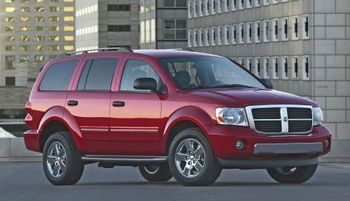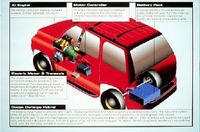.
Dodge Durango Hybrid: Difference between revisions
No edit summary |
No edit summary |
||
| Line 5: | Line 5: | ||
[[Image:Durango Hybrid Cutaway.jpg|200px|left|]] | [[Image:Durango Hybrid Cutaway.jpg|200px|left|]] | ||
The [[Global Hybrid Cooperation|collaboration]] between these companies has yielded a patented [[Full Hybrid|two mode full hybrid system]] which maximizes efficiency for city and highway driving. In the first mode, at low speeds, the vehicle can operate in one of 3 ways: electric only, engine power only or in any combination of engine and electric power. The second mode combines electronic controls, such as Active Fuel Management ( | The [[Global Hybrid Cooperation|collaboration]] between these companies has yielded a patented [[Full Hybrid|two mode full hybrid system]] which maximizes efficiency for city and highway driving. In the first mode, at low speeds, the vehicle can operate in one of 3 ways: electric only, engine power only or in any combination of engine and electric power. The second mode combines electronic controls, such as Active Fuel Management (Cylinder deactivation), cam phasing, and late-intake valve closure, allowing even more efficient engine operation. The [[Hybrid Cars|hybrid]]-electric drive system is based on the technology in GM's [[Hybrid Cars|hybrid]] transit buses. The result is said to be a 25 percent improvement in composite fuel efficiency. | ||
Because the architecture can be scaled to fit multiple vehicles and adapted to [[Gasoline|gasoline]] or [[Diesel|diesel]] engines, the [[Global Hybrid Cooperation|two-mode full hybrid]] can be applied globally. | Because the architecture can be scaled to fit multiple vehicles and adapted to [[Gasoline|gasoline]] or [[Diesel|diesel]] engines, the [[Global Hybrid Cooperation|two-mode full hybrid]] can be applied globally. | ||
Revision as of 13:27, 6 July 2006
Chrysler will begin production of a hybrid version of the Dodge Durango at its Newark Assembly plant in Delaware. The hybrid system for these vehicles is being developed jointly by a GM, BMW, and DaimlerChrysler partnership
The same system will also be available on GM's Chevrolet Tahoe Hybrid and GMC Yukon Hybrid SUV models. Production of the Durango is scheduled to begin shortly after the General Motors launch of those SUVs in late 2007.
The collaboration between these companies has yielded a patented two mode full hybrid system which maximizes efficiency for city and highway driving. In the first mode, at low speeds, the vehicle can operate in one of 3 ways: electric only, engine power only or in any combination of engine and electric power. The second mode combines electronic controls, such as Active Fuel Management (Cylinder deactivation), cam phasing, and late-intake valve closure, allowing even more efficient engine operation. The hybrid-electric drive system is based on the technology in GM's hybrid transit buses. The result is said to be a 25 percent improvement in composite fuel efficiency.
Because the architecture can be scaled to fit multiple vehicles and adapted to gasoline or diesel engines, the two-mode full hybrid can be applied globally.
A facelift for the Dodge Durango also looks to be on the agenda when released as a hybrid, although it is suspected that changes will be minor.
For further information on the non-hybrid version see Wikicars comprehensive Dodge Durango
Pricing
Pricing has not been announced.
Gas Mileage
It is hoped that the Dodge Durango will achieve a 25 percent improvement in composite fuel efficiency over the non-hybrid version.


